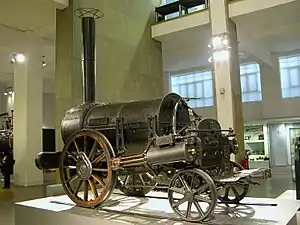
Iron horse is a pervasive term (considered by the early 21st century to be transitioning into an archaic reference) for a steam locomotive and the railway on which it travels, originating in the early 1800s, when horses still powered most machinery.[1][2]
The term was common and popular in both British and North American literary articles.
Use of the term
Iron horse was used admiringly when comparing early road and railway traction engine performance to slower, less powerful horse-powered tramways. The usage of the word 'Iron' reflecting the material required for functioning railways is found as early as 1825.[3][4]
The iron horse term became widely popularized and found frequent use in the century-and-a-half following the competition won by Stephenson's Rocket, in innumerable newspaper articles as well as in various novels.
In understanding the role of railways in political terms, the idea of the railway and locomotives as extending countries power over others is found in historical studies, [5][6] and colonialism studies.[7] In academic and popular renditions of railway history, the term was used frequently.[8][9][10][11]
The term's historical context, and its use in films and other media, is extensive.[12] The understanding of the development of railways was not confined to America or Australia, the term was across cultural boundaries such as the Huenemann book about railways in China 'The Dragon and the Iron Horse'.[13]
In Australia the film Iron Horse was well noted as an indicator of the usage of the term to do with expansion of railways across the continent.[14][15] In the United States the 'Iron Horse' was a component of national,[16] state histories,[17] of the Civil War,[18] even as a component of Constitutional history.[19]
It began to decline in use, at least in North American colloquial expression, with the decline in rail transport as the primary mode of transport.
The more recent usages of the term show a continuity in titles of films and places - such as the Iron Horse (TV series), and in California, the Iron Horse Regional Trail.
References
- ↑ "Iron horse". Random House Dictionary. dictionary.com. Retrieved 29 September 2010.
–noun Older Use. A locomotive. Origin: 1825–35
- ↑ Noting the term was not found in the twentieth century editions of the Oxford English Dictionary
- ↑ Gray, Thomas (1825), Observations on a general iron rail-way, or land steam-conveyance : to supersede the necessity of horses in all public vehicles ... containing every species of information relative to rail-roads and loco-motive engines (5th ed, with maps and plates illustrative of the plan ed.), Baldwin, Cradock, and Joy, retrieved 6 September 2023
- ↑ Edwards, Peter; Edwards, Peter (Peter Roger); Enenkel, K. A. E; Graham, Elspeth, 1953-; Ebook Library (2012), The horse as cultural icon : the real and symbolic horse in the early modern world, Brill, ISBN 978-90-04-22242-7
{{citation}}: CS1 maint: multiple names: authors list (link) CS1 maint: numeric names: authors list (link) - ↑ Lewis, Daniel (2007), Iron horse imperialism : the Southern Pacific of Mexico, 1880-1951, University of Arizona Press, ISBN 978-0-8165-2604-8
- ↑ "IRON-HORSE IMPERIALISM. (7 February 1934)", The Bulletin, John Haynes and J.F. Archibald, 55 (2817): 8, 1934-02-07, ISSN 0007-4039
- ↑ Corpuz, Arturo G (1999), The colonial iron horse : railroads and regional development in the Philippines, 1875-1935, University of the Philippines Press, ISBN 978-971-542-220-8
- ↑ Walter, John (2016), The iron horse : the history and development of steam locomotive, History Press, ISBN 978-0-7509-6716-7
- ↑ Burke, David; New South Wales Rail Transport Museum; Australian Railway Historical Society. New South Wales Division (1986), Man of steam : E.E. Lucy - a gentleman engineer in the great days of the iron horse, Iron Horse Press in association with Australian Railway Historical Society (N.S.W. Division), N.S.W. Rail Transport Museum, ISBN 978-0-9588340-0-1
- ↑ Westwood, John (2001), World railways : an illustrated history of the iron horse, PRC Publishing, ISBN 978-1-85648-599-9
- ↑ Horsfield, Brenda.Steam horse, iron road; edited by Brenda Horsfield. London, British Broadcasting Corporation, 1972.
- ↑ ""Iron Horse" Progress". Newcastle Morning Herald and Miners' Advocate. No. 23, 060. New South Wales, Australia. 29 August 1950. p. 5. Retrieved 5 September 2023 – via National Library of Australia.
- ↑ Huenemann, Ralph William (1984), The Dragon and the Iron Horse, Harvard University Asia Center, ISBN 978-1-68417-243-6
- ↑ "The Iron Horse". Warwick Daily News. No. 2545. Queensland, Australia. 17 August 1927. p. 8. Retrieved 5 September 2023 – via National Library of Australia.
- ↑ ""The Iron Horse"". The Queanbeyan Age And Queanbeyan Observer. New South Wales, Australia. 4 May 1926. p. 2. Retrieved 5 September 2023 – via National Library of Australia.
- ↑ https://www.history.com/this-day-in-history/president-jackson-rides-the-iron-horse
- ↑ Iron horse in the pinelands : building west Florida's railroad, 1881-1883 : a centennial history / by Jesse Earle Bowden ... [et al.] ; edited by Virginia Parks.Pensacola, Fla. : Pensacola Historical Society, 1982
- ↑ Lash, Jeffrey N. (Jeffrey Norman) (1991), Destroyer of the iron horse : general Joseph E. Johnston and confederate rail transport, 1861-1865, Kent State University Press, ISBN 978-0-87338-423-0
- ↑ Richard C. Cortner (1993), The iron horse and the Constitution the railroads and the transformation of the fourteenth amendment, Westport, Conn Greenwood Press, ISBN 978-0-313-28578-3